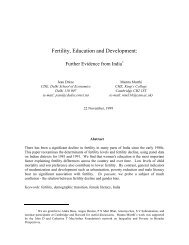You also want an ePaper? Increase the reach of your titles
YUMPU automatically turns print PDFs into web optimized ePapers that Google loves.
Viscosa via a long resident Italian businessman in Bombay, a Dr Rossi, while Kothary<br />
handled only the Du Pont product from the United States and elsewhere. Dhirubhai<br />
was a sporting rival, Kothary said: ‘He would always say: “This is what I’m going to<br />
do, boy!” Whenever he fights an enemy he goes in the open.’ Not everyone in the<br />
Bombay textile trade would agree.<br />
Kothary and many others in the Pydhonie market remember intervention in a market<br />
crisis in the mid-1960s when spiralling textile prices led government authorities to<br />
crack down on speculation in the yarn market by banning forward trading, and then<br />
arresting traders found to be continuing the practice. Consumers must have<br />
complained to the government about fluctuations in prices-some people, about a<br />
dozen, were arrested in the market,’ Kothary said.<br />
<strong>The</strong> trading community was despondent as their colleagues languished all day in the<br />
cells of the Picket Road Police Station. Approaches to officials by the Bombay Yarn<br />
Markets and Exchange Association got nowhere. <strong>The</strong>n, late in the evening, Dhirubhai<br />
arrived like a storm at the police station, shouting greetings to the senior officers,<br />
and handing out snacks to everyone. Within an hour, all the arrested traders had<br />
been released, and the complaints against them shelved. Kothary can only guess at<br />
intervention. ‘<strong>The</strong> usual-India!’ he said.<br />
Dhirubhai also emerged as saviour of the market when an even greater supply crisis<br />
occurred in 1967, Kothary recalled. On a report that actual user import licences had<br />
been traded and misused, the Customs authorities in Bombay under the then<br />
Assistant Collector, a Mr. Ramchandani, impounded all incoming cargoes of artificial<br />
fibres. <strong>The</strong> government insisted that whoever imported the yarn had to be the<br />
manufacturer who wove it into cloth.<br />
According to Kothary, about 40 million rupees (then about US$5.3 million) worth of<br />
yarn was seized. Many traders then defaulted on loans taken out to cover the<br />
imports. <strong>The</strong> entire artificial textile market was paralysed. ‘It could have made us all<br />
insolvent,’ Kothary said. ‘This is when I came very closely in touch with Dhirubhai. It<br />
was he who saved us all. We fought for about six months. I used to go with him to<br />
lawyers day in and day out. We went to Delhi to see Morarji Desai [then finance<br />
minister]. That was the time I could see he was a wizard. He used all the ways and<br />
means.’ <strong>The</strong> crisis ended as quickly as it started, ostensibly after a one-day hearing<br />
of the importers’ appeal in the Customs, Excise and Gold Appellate Tribunal under<br />
Justice Oberoi, who found for the appeal. Kothary indicates that an agreement<br />
engineered by Dhirubhai was behind the judicial settlement. <strong>The</strong> details are not<br />
revealed, but presumably come under the category of ‘That India!’ also.<br />
On their move to Bombay, Dhirubhai and his young family had moved into an<br />
apartment on the 3rd floor of the Jai Hind Society building in Bhuleshwar, a very<br />
crowded district of shops, markets and residential tenements in the central part of<br />
the city. <strong>The</strong> building is what is known as a chawl in Bombay: numerous small<br />
apartments, often just single rooms, opening on to open galleries around a central<br />
courtyard which is set back from the street behind commercial premises. Quite often<br />
the toilets and washing facilities are shared at ground level.<br />
Later accounts of Dhirubhai’s early career often paint this home as Dickensian in the<br />
extreme. <strong>The</strong> fat, since bought by a later tenant, had two small bedrooms, a living<br />
room, kitchen and internal bathroom in 1995. Vakharia, who used to visit the<br />
Ambanis for a holiday each Christmas from 1959 to the late 1960s, remembers it




